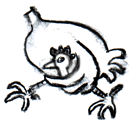Remote-controlled fruit flies
ScienceDirect - Cell: Remote Control of Behavior through Genetically Targeted Photostimulation of Neurons: You gotta love this! How many contemporary science journals publish an article that cites a source from the 18th century? This article, published last April on remote-control of Drosophila melanogaster via lasers starts off by citing Galvani's famous De viribus electricitatis in motu musculari commentarius (Bologna: Typographia Instituti Scientiarium, 1791). Susana Q. Lima and Gero Miesenböck, from the Department of Cell Biology, Yale University School of Medicine write in Cell:
if ... the intended target cells are equipped with a “receiver” that allows them to decode a publicly broadcast stimulus, multiple targets might be addressed simultaneously and selectively... The capacity to control defined populations of neurons noninvasively would represent a significant step in moving neuroscience from passive observation—which neuronal activity patterns are correlated with a given behavior?—to active and predictive manipulation of behavior.
We report experiments in Drosophila that realize this scenario. Unfocused laser light played the part of the publicly broadcast stimulus; genetically encoded “phototriggers” of action potentials ... served as the cell type-specific receivers that transduced the optical signal into electrical activity. Brief pulses of laser light allowed us to activate genetically circumscribed groups of central neurons and control specific behaviors in flies moving freely within the optical field. ...genetically targeted photostimulation was used to investigate the role of dopaminergic neurons in the control of movement. We found that an acute increase in dopaminergic signaling alters the extent of locomotor activity and the walking patterns in which this activity is expressed.



0 Comments:
Post a Comment
<< Home